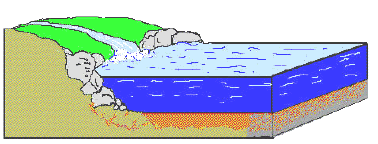|
Once sediments are formed during weathering, the particles are
transported by the action of streams, wind, glaciers, or gravity.
Eventually the clastic sediment is deposited, usually in a low
area like a lake or the ocean.
Imagine a stream flowing out of the mountains into the ocean. As the
water flows quickly downhill, it carries all kinds of sediment
particles, from mud to sand sized grains, to larger gravel and pebbles.
As the stream enters the ocean, the water slows down and deposits the
sediment. The heaviest sediment grains (gravel and pebbles) drop out
first and the lightest (mud), settles to the floor of the ocean further
offshore. A major factor to classify clastic sedimentary rocks is the
size of the sediment.
Organisms that live in environments where sediments are formed will
die. Their remains accumulate and are incorporated into rocks. When you
find fossils in rocks they are referred to as fossiliferous
sedimentary rocks.

Particles move into the open ocean or lake from a river
and settle by size and density.
|

Gravel along a river bed
|